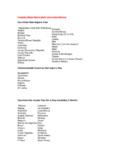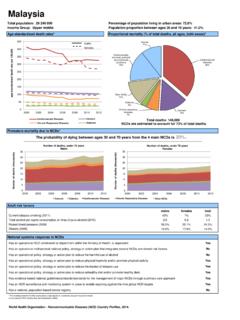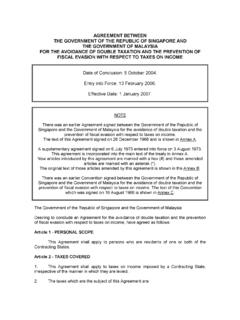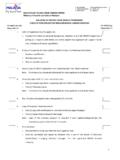Transcription of Malaysia Tropical Fruits and Vegetables in …
1 Fruits and Vegetables for Health Workshop 15-16 August 2006, Seoul, Korea Tropical Fruits and Vegetables in Malaysia : Production and impact on health Dr. Mohamed Mohd. Salleh Deputy Director, Horticulture Research Centre, Malaysian Agricultural Research and Development Institute (MARDI). Dr. Rokiah Mohd. Yusof Associate Professor, Faculty of Medicine and Health Sciences, Universiti Putra Malaysia . Introduction Agriculture contributes , which is worth about billions, to Gross Domestic Products (GDP) of Malaysia . Sixty-one percent of the contribution comes from industrial crops such as oil palm, rubber and cocoa, and 39% from agricultural food crops including Fruits and Vegetables . Malaysia has about 4 million hectares of agricultural land and only 20% is being cultivated with food crops.
2 The export earnings from agricultural sector is about USD10 billions in 2004 and only comes from food sector. Malaysia imports about billion worth of food each year and currently facing a deficit at about billions. Fruits AND Vegetables PRODUCTION. Government Policies on Agriculture Agricultural development in Malaysia is governed by two major policies. Third National Agricultural Policy (1998-2010) recognizes agriculture as the third engine of growth, after manufacturing and service sectors. Ninth Malaysia Development Plan (2006-2010) on the other hand reemphasized the role of agriculture in the development for the country as well as targeting the balance of trade. fruit Production Total area planted with Fruits in Malaysia is about 310,000 ha. The production is at million metric tons (mt) and export value of millions to mainly Singapore, Hong Kong and Middle East.
3 Malaysia is still a net importer of fresh as well as processed Fruits and the import value of fresh Fruits is approximately at USD174 millions. Per capita consumption of Fruits is currently at Under 9th Malaysia Plan, fruit production will be increased from million mt in 2005 to million mt in 2010, an increase of 10% per annum. This means that Malaysia will increase in self sufficiency level (SSL) for Fruits from current 117% to 138% by 2010. Eight major Fruits given more emphasised for domestic as well as for export markets are pineapple, papaya, watermelon, starfruit, banana, citrus, mangosteen and durian (Table 1). vegetable Production Total area planted with Vegetables in Malaysia is about 44,000 ha. The production is at 637,000 million mt and export value of millions to mainly Singapore.
4 Malaysia imports mainly temperate Vegetables from China, Taiwan and Thailand at millions. Per capita consumption of Vegetables is currently at Under 9th Malaysia Plan, vegetable production will be increased from 771,300 mt in 2005 to million mt in 2010, an increase of about 8% per annum. Self sufficiency level for Vegetables will also be increased from current 74 to 108% by 2010. Popular Vegetables to be promoted are as in Table 2. Growers are slowly producing organic Vegetables but the demand is still very small. In order to overcome the excessive use of pesticides, the government has institutionalised good agricultural practices through Malaysian Farm Certification Scheme for Good Agricultural Practice to both fruit and vegetable growers. The growers are encouraged to register for the scheme for free and the produce from these farms will be given priority for established hyper and export markets.
5 Strategies to Achieving fruit and vegetable Productions Targets Several strategies have been outlined to increase the production of both Fruits and Vegetables . Traditional farms will be converted into modern farms using latest technologies and knowledge-based production systems. Similarly, idle lands will also be consolidated and rehabilitated with improved infrastructures, drainage and irrigation facilities. Permanent food production parks will be set up to ensure sustainability of food production in the country. For priority Fruits and Vegetables , the Malaysian government will set up contract farms with guaranteed markets, minimum prices and easier access to markets. The government will also ensure adequate funds are available for investment and the farmers can get easier access to credits.
6 The small and medium enterprises are also encouraged to process Fruits &. Vegetables into ready to eat minimally processed or fully processed products. HEALTH RELATED ASPECTS OF Fruits AND Vegetables . Dietary Pattern of Malaysians Fundamental changes in food supply patterns emerged in recent decades. Total calories available for consumption have increased by over the past three decades. Major increase comes from Vegetables oil, animal products, especially poultry meat, eggs, milk, fish and sugar. The lower income groups tend to depend on a limited range of food items for calories such as rice, flour, cooking oil and sugar. In contrast, people in higher income tend to consume a wider variety of food including more dairy products, Fruits and Vegetables 2. Benefits of Fruits and Vegetables Malaysian Tropical Fruits have many health benefits.
7 Fruits in general are high in fibre which is necessary to improve digestion and prevent constipation and has no cholesterol. Malaysian Tropical Fruits contain a variety of micronutrients, vitamins, minerals, carotenoids, riboflavin, niacin and other phytochemicals. Some of these Fruits are reputed to be able to prevent certain non communicable diseases such as blood pressure, diabetes, lower cholesterol or even cancer. In another word, healthy diet of Fruits and vegetable since young can build a strong immune system, and maintain a healthy body. Like Fruits , Vegetables are also rich in fiber, no cholesterol and low in calories. They are rich in vitamin C and A, folic acid and minerals, which are necessary for growth and healthy body with sound mind. Vegetables can also help to improve skin tissues, eyes, bones and the brain.
8 In Malaysia , it is not uncommon for the people to eat wild Vegetables or herbs known as ulams, as salads. Some of these wild ulams are high in calcium, phosphorus, sodium, iron and potassium. Since ulams are eaten raw, their nutritional contents are not destroyed by heat. Government Campaigns and Promotion of Healthy Nutrition The government does not have a campaign specifically meant to promote eating Fruits and Vegetables . However, there are numerous campaigns which include the promotion of fruit and Vegetables for health. The green book campaign launched by the Ministry of Agriculture on 3 March 2006, promotes everybody to plant more Fruits and Vegetables as landscape around the house. This so call edible landscape is one way to encourage the Malaysians to eat more Vegetables .
9 In 1997, Healthy Lifestyle Campaign with the theme of Food for health: Recipe for healthy life', amongst recommended diet for health includes diet high in legumes, Fruits and Vegetables . The campaign was targeted at the hotels, restaurants, fast food outlets, school canteens as well as the street hawkers. In this campaign, Fruits are encouraged to be eaten as dessert and vegetable as part of every meal, if possible five servings a day. The public, especially the children were encouraged to drink fruit juices without sugar as part of breakfast or meal. Campaign eating Fruits and vegetable was also aimed at young children. Under Balance Diet Campaign, children between the ages of 2-6 are encouraged to eat more Fruits and Vegetables . For children below the age of 2-6, two table spoon of Vegetables and one or a piece of fruit per day.
10 Bright Start Nutrition project started by Malaysian Nutrition Society is another dedicated nutrition education programme targeted to young children. This project emphasized the Food Guide Pyramid, where Fruits and vegetable are positioned as the second level after carbohydrates to be consumed. Malaysian Nutrition Society as a non-governmental organization has done a lot of effort in promoting eating Fruits and Vegetables especially among the children through its website, Nutriweb. 3. CONCLUSION. The fruit and vegetable industries in Malaysia have the potential to further grow and contribute to the expansion of the agricultural sector. The Third National Agricultural Policy has stressed that fruit and vegetable productions be upgraded to meet the growing domestic and export markets.

















